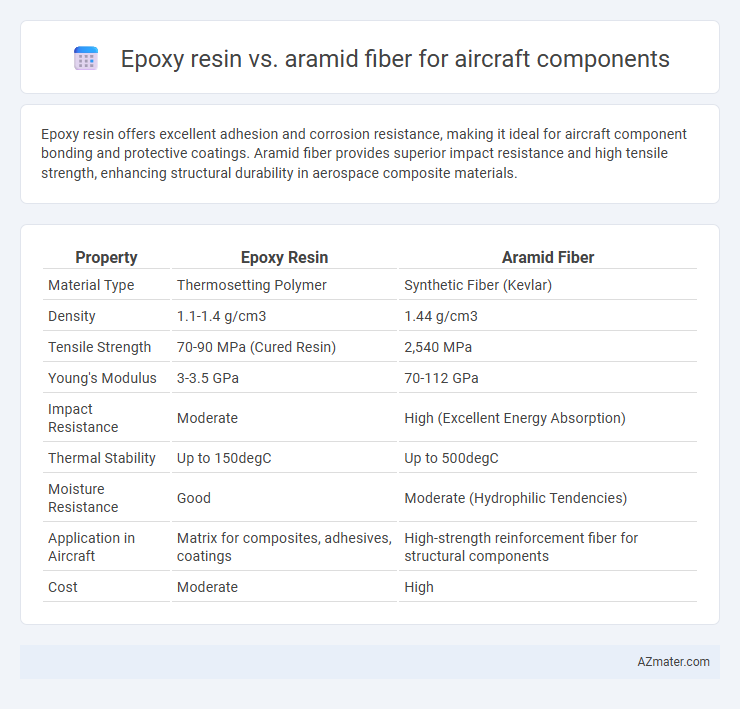Epoxy resin offers excellent adhesion and corrosion resistance, making it ideal for aircraft component bonding and protective coatings. Aramid fiber provides superior impact resistance and high tensile strength, enhancing structural durability in aerospace composite materials.
Table of Comparison
| Property | Epoxy Resin | Aramid Fiber |
|---|---|---|
| Material Type | Thermosetting Polymer | Synthetic Fiber (Kevlar) |
| Density | 1.1-1.4 g/cm3 | 1.44 g/cm3 |
| Tensile Strength | 70-90 MPa (Cured Resin) | 2,540 MPa |
| Young's Modulus | 3-3.5 GPa | 70-112 GPa |
| Impact Resistance | Moderate | High (Excellent Energy Absorption) |
| Thermal Stability | Up to 150degC | Up to 500degC |
| Moisture Resistance | Good | Moderate (Hydrophilic Tendencies) |
| Application in Aircraft | Matrix for composites, adhesives, coatings | High-strength reinforcement fiber for structural components |
| Cost | Moderate | High |
Introduction to Composite Materials in Aircraft
Epoxy resin and aramid fiber are essential components in advanced composite materials used in aircraft manufacturing, offering high strength-to-weight ratios crucial for aerospace applications. Epoxy resin acts as a durable matrix that binds aramid fibers, such as Kevlar, providing exceptional impact resistance and fatigue performance while maintaining lightweight properties. These composites enhance structural integrity and fuel efficiency compared to traditional metals, making them integral to modern aircraft design.
Overview of Epoxy Resin and Aramid Fiber
Epoxy resin is a thermosetting polymer widely used in aircraft components due to its excellent adhesive properties, high mechanical strength, and resistance to environmental degradation. Aramid fiber, such as Kevlar, is known for its exceptional tensile strength, impact resistance, and lightweight nature, making it ideal for reinforcing composite materials in aerospace applications. Combining epoxy resin with aramid fibers results in composite materials that offer enhanced durability, flexibility, and performance under extreme flight conditions.
Mechanical Properties Comparison
Epoxy resin offers excellent tensile strength and high stiffness, making it ideal for load-bearing aircraft components, while Aramid fiber provides superior impact resistance and exceptional toughness with lower density. The combination of epoxy resin with Aramid fibers results in lightweight composites exhibiting enhanced fatigue resistance and improved energy absorption, crucial for aircraft structural integrity. Mechanical properties such as Young's modulus, tensile strength, and elongation at break vary, with epoxy resin composites showing higher stiffness and Aramid fiber composites offering greater flexibility and damage tolerance.
Weight-to-Strength Ratio Analysis
Aramid fiber composites exhibit a superior weight-to-strength ratio compared to epoxy resin alone, making them highly suitable for aircraft components requiring lightweight yet strong materials. While epoxy resin provides excellent matrix bonding and corrosion resistance, the integration of aramid fibers significantly enhances tensile strength and impact resistance without adding substantial weight. This combination results in optimized structural performance crucial for aerospace applications where minimizing weight while maximizing strength is vital.
Durability and Environmental Resistance
Epoxy resin exhibits excellent durability and superior environmental resistance, including high moisture, chemical, and temperature tolerance, making it ideal for protecting aircraft components from corrosion and degradation. Aramid fiber, known for exceptional impact resistance and tensile strength, offers outstanding durability against mechanical stresses but is more susceptible to moisture absorption and UV degradation without proper resin encapsulation. Combining epoxy resin with aramid fiber in composite aircraft components enhances overall durability and environmental resistance by leveraging epoxy's protective properties and aramid's strength.
Manufacturing and Processing Techniques
Epoxy resin, widely used in aerospace composites, offers excellent adhesion, thermal stability, and ease of curing through techniques like vacuum bagging and autoclave processing, enabling high-strength, lightweight aircraft components. Aramid fiber, commonly known as Kevlar, requires specialized wet lay-up or filament winding methods to integrate its high tensile strength and impact resistance into aircraft parts, demanding precise control of resin impregnation and curing cycles to maintain fiber integrity. Manufacturing with epoxy resin generally allows more straightforward processing and faster cycle times, whereas aramid fiber components necessitate careful handling to prevent fiber damage and ensure optimal composite performance in aerospace applications.
Cost Considerations
Epoxy resin offers a cost-effective matrix material widely used in aircraft components due to its affordable price and strong bonding properties. Aramid fiber, while providing superior impact resistance and toughness, typically incurs higher costs driven by complex manufacturing processes and raw material expenses. Balancing budget constraints and performance requirements is critical when selecting epoxy resin or aramid fiber for aerospace structural applications.
Performance in Aerospace Applications
Epoxy resin offers exceptional adhesion, chemical resistance, and thermal stability, making it ideal for bonding and matrix materials in aerospace composites. Aramid fiber provides superior impact resistance, high tensile strength, and excellent energy absorption, enhancing the structural integrity of aircraft components under dynamic loads. The combination of epoxy resin with aramid fibers results in lightweight, durable materials capable of withstanding extreme stress and environmental conditions critical for advanced aerospace performance.
Safety and Maintenance Factors
Epoxy resin offers superior corrosion resistance and excellent adhesion, enhancing the structural integrity of aircraft components under extreme conditions, which improves safety by reducing the risk of material failure. Aramid fiber, known for its exceptional impact resistance and high strength-to-weight ratio, provides enhanced damage tolerance and fatigue resistance, lowering maintenance frequency and costs in aerospace applications. Combining epoxy resin with aramid fiber creates lightweight, durable composites that meet stringent aviation safety standards and simplify maintenance protocols.
Conclusion and Material Selection Guidelines
Epoxy resin combined with aramid fiber offers exceptional strength-to-weight ratio and impact resistance ideal for aircraft components, ensuring durability and safety under dynamic loads. Material selection should prioritize epoxy-aramid composites for applications requiring high toughness and resistance to abrasion, while considering factors such as cost, environmental resistance, and ease of fabrication. Optimal performance in aerospace structures is achieved by balancing mechanical properties with weight savings and long-term reliability specific to operational conditions.

Infographic: Epoxy resin vs Aramid fiber for Aircraft component
 azmater.com
azmater.com